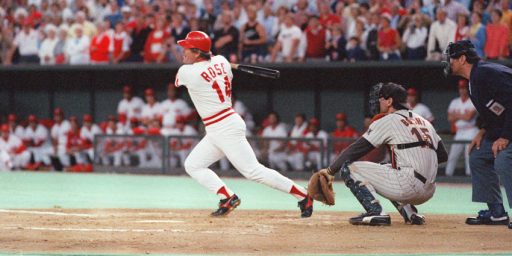Moneyball Confirmed
Steve is perhaps more qualified to discuss the following study, but I’ll comment anyway since it strikes me as pretty technically sound. Two economists recently tested the hypothesis of Michael Lewis’s baseball classic and found — unsurprisingly to hard-core fans like myself — that it held. Specifically, a player’s ability to get on base had indeed been undervalued in the sport’s labor market, allowing budget-conscious franchises like the Oakland Athletics to put together competitive teams:
An Economic Evaluation of the Moneyball Hypothesis
In the first four years of data, the slugging coefficients are all statistically significant and of similar magnitude, ranging between 2.05 and 3.10. In contrast, the on base percentage coefficients are smaller than their slugging counterparts (between —0.13 and 1.36) in each of these years and are not significantly related to log salary. The lack of a market premium for hitters with superior skill at reaching base validates the Athletic’s systematic approach to identifying such players, and thereby winning games at a discount relative to their competition.
Interestingly, authors Jahn Hakes and Raymond Sauer also note that the market has since corrected itself:
The relative valuation of on base and slugging percentage is abruptly reversed for the year 2004. The returns to slugging are similar in 2004 to prior years, but this is the first year for which the ability to reach base is statistically significant. The labor market in 2004 appears to have substantially corrected the apparent inefficiency in prior years, as the coefficient of on base percentage jumps to 3.68, and the ratio of the monetary returns to reaching base and slugging is very close to the ratio of the statistics̢۪ contributions to team win percentage.
How exactly did the market correction take place? Did entrenched general managers suddenly become convinced of Moneyball and change their business strategies? Not really:
The particular margin of inefficiency emphasized in Moneyball, undervaluation of a batter’s ability to get on base, appears to have been substantially if not completely eroded by the time the book was published. Despite protests from baseball traditionalists (Lewis, 2004) that the book was somehow misguided, several major league teams had by this time decided to imitate the strategy.
During and after the 2003 season, two young analysts from the Athletics’ front office were hired as General Managers by the Toronto Blue Jays and the Los Angeles Dodgers (Joe Saraceno, 2004). Although the Boston Red Sox failed in their attempt to hire both the Athletics’ General Manager (Billy Beane) and Assistant GM, they followed Beane’s advice by hiring Theo Epstein, making him the youngest GM in baseball history (Shaughnessy, 2003). In addition, the Sox hired the father of sabermetrics, Bill James himself, in an advisory capacity. This diffusion of statistical knowledge across a handful of decision-making units in baseball was apparently sufficient to correct the mis-pricing of skill.
In other words, clubs simply hired away the talent, making the trend both encouraging and unsatisfying. It’s encouraging because owners have seen what works and made at least some effort to experiment. It’s unsatisfying because the Moneyball hypothesis itself hasn’t necessarily changed old-school baseball people’s minds (and if it has, the change has been limited). But that’s to be expected: people in all social settings are resistant, especially when they have a vested interest in business-as-usual. So while sabermetricians should continue to spread the gospel, they should take pride in what has thus far been accomplished.
Update: It’s probably instructive to consider these findings in light of today’s story about Jason Giambi, whose value came — perhaps contrary to his own personal beliefs — as much from plate discipline as from power. In 2001, arguably his best year, he hit fewer than 40 homers but reached base at an astonishing clip of .477.





Memo to self: Sell sluggers, buy “on base percentage.”